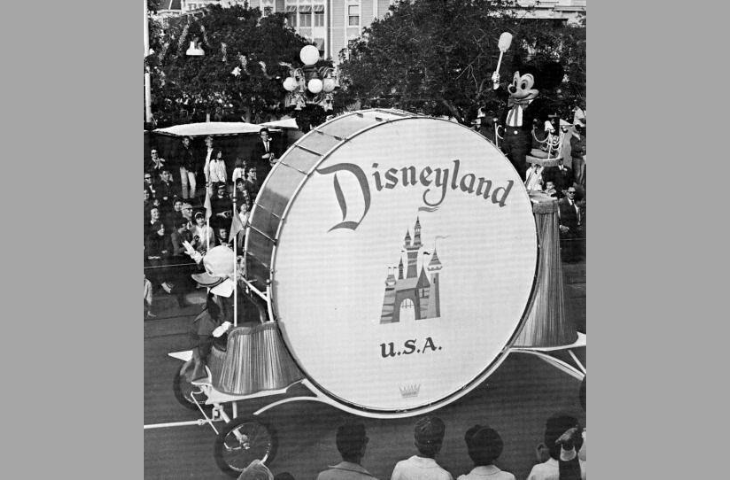September 2022
Fig.1

Bass drum, Thomas Key, London, 1807-1813, inv. 3105
Fig.2

Bass drum, Thomas Key, London, 1807-1813, inv. 3105
Fig.3

Big Bass Drum at Disneyland (United-States, 1960’s), tweet by MagiclandPark, 2017
Punch in the chest
Among the percussion instruments, there is one that can be heard with great emphasis and whose sounds literally punch in the chest: the bass drum. Whether in a military band, a local brass band, a symphony orchestra, a rock band, a jazz band or any other ensemble, it is the guarantor of the basic pulse, the rhythmic regularity, the square beat and many other effects.
The bass drum is the biggest member of the large family of cylindrical tubular membranophones, otherwise known as drums in their most common form. Producing sounds of indefinite pitch, but rather low, the bass drum is composed of a cylindrical shell of wood and one or two heads (animal or synthetic) attached to the edges of the shell and held in place by a wooden band. The heads are stretched with a rope or, on more recent models, with threaded rods. There are single-headed and double-headed bass drums – with a playing side and a resonance side. It can be played upright or at an angle, sometimes even horizontally. The bass drum is usually struck by one or two sticks – or mallets – with a felt head. Several other types of beaters can also be used. The drum kit bass drum is played with a foot pedal.
Bass drums come in a variety of sizes: both the diameter and the height of the shell can vary significantly, from the smaller bass drums of jazz drum kits to the imposing bass drums of symphony orchestras. In the middle of the 19th century, the firm Distin even marketed “the world’s largest drum” with a diameter of 240 cm, while a specimen of more than 370 cm was made especially for Disneyland in 1961!
The oriental origins of the bass drum are attested since the 1st or 2nd century BC, while its direct ancestor, the davul, was identified in the eastern Mediterranean in the 14th century. Rather rare in the West until the eighteenth century, the bass drum then benefited from Turkish fashion and the popularity of the Janissary bands. It was introduced to the orchestra by Gluck in 1761, then Mozart used it in his opera Die Entführung aus dem Serail (1782), soon to be imitated by Haydn, Beethoven and many others. Verdi called for a gran cassa, the largest available bass drum, in his famous Requiem (1874). In the 20th century, Stravinsky wrote a heroic passage for the instrument in his Rite of Spring (1913). And almost a century later, Prokofiev (Gabriel, Sergei’s grandson) finally composed a Concerto for Bass Drum and Orchestra (2012).
Relic of Waterloo
The bass drum is also an important element in military music. Its presence has been seen in Ottoman armies, but it has also long been found in Western military music, where it sets the pace in marches and other pas redoublés. And when military music accompanies soldiers on the battlefield, collateral damage is not impossible. An exemplar kept at the MIM has thus had a singular history and has participated in History with a capital H.
Indeed, this bass drum was used during the battle of Waterloo on 18 June 1815, on the side of the Coalition against Napoleon. In the general tumult of the fighting, it was abandoned by its player and remained on the “dismal plain” for an indeterminate period. It was picked up by a passer-by, probably repaired, and was then used for many years in a band in the vicinity of Brussels. The instrument was finally acquired by Mahillon & Co., who donated it to the Brussels’ Instrumental Museum shortly before the First World War. The bass drum has been in the MIM’s collection since that time.
On the barrel of the instrument is painted the British coat of arms with the French motto “Honni soit qui mal y pense”. There is also a medallion bearing the initials G R referring to King George III and one can read the military affiliation of the instrument to the “VIIth (Queen’s own Hussars)”, the Queen’s 7th Regiment of Hussars. A label on the barrel gives information about the maker, Thomas Key, who set up his workshop between 1807 and 1813 at number 2, Pall Mall, a famous London street. Key, who was both a publisher and an official wind instrument maker, is described as “Real manufacturer of Bass, Tenor, Side and Kettle Drums of wood, brass, copper and silver”.
It is interesting to note that in 1885, this bass drum crossed the Channel again and returned to British soil for some time, on loan from its then owner, Mahillon, to the International Inventions Exhibition in London. It was rightly presented there as an authentic “relic of Waterloo”.
Text: Géry Dumoulin